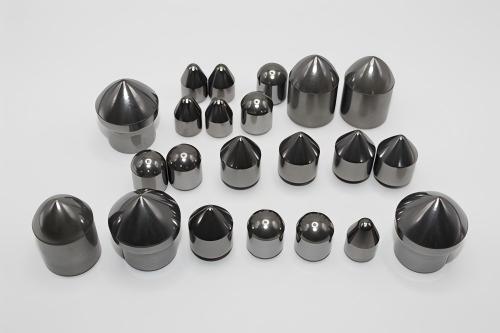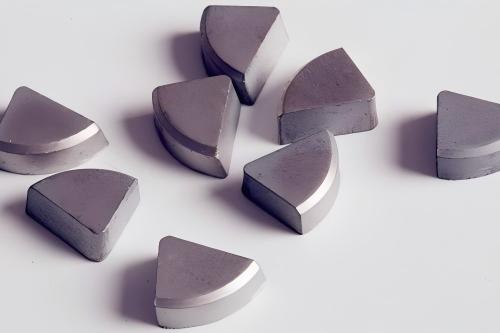YG6 VS YG8 : A Comparison of Their Applications and Selection
I. Definition and Composition Characteristics of YG Series Cemented Carbide Grades
Cemented carbide is an alloy material produced through powder metallurgy processes from refractory metal carbides (such as Tungsten Carbide, WC) and binder metals (such as Cobalt, Co). YG6 VS YG8 are cemented carbide grades under the Chinese standard. As the most representative category within the YG series, their grade naming follows industry conventions: “Y” stands for “Ying Zhi He Jin” (hard alloy, from the pinyin initial), “G” stands for the binder metal “Gu” (Cobalt, from the pinyin initial), and the subsequent number indicates the mass percentage of Cobalt.
YG6: Tungsten Carbide (WC) mass fraction is approximately 94%, Cobalt (Co) mass fraction is 6%, belonging to the low-cobalt content cemented carbide. Its room temperature hardness can reach HRA 89.5-92, density is 14.6-15.0 g/cm³, transverse rupture strength is approximately 1400-1600 MPa, and thermal conductivity is approximately 75 W/(m·K). It possesses the core characteristics of high hardness and high wear resistance.
YG8: Tungsten Carbide (WC) mass fraction is approximately 92%, Cobalt (Co) mass fraction is 8%, belonging to the medium-cobalt content cemented carbide. Its room temperature hardness is HRA 89-90, density is 14.5-14.9 g/cm³, transverse rupture strength increases to 1600-1800 MPa, and thermal conductivity is approximately 70 W/(m·K). It offers more prominent toughness and impact resistance.
Cobalt content is the core factor causing the performance difference between the two grades: Cobalt acts as the binder phase; a higher content enhances the alloy’s toughness and impact resistance, but correspondingly reduces hardness and wear resistance. Conversely, a lower cobalt content improves hardness and wear resistance, but reduces toughness.
II. Core Application Areas of YG6 VS YG8
The YG series is widely used in mechanical processing, mining, electronic manufacturing, and other fields due to its good thermal conductivity, anti-adhesion properties (less prone to chemical reactions with non-ferrous metals), and strong adaptability to machining brittle materials. The specific application scenarios of the two grades have their own emphases:
(1) Typical Applications of YG6
Mechanical Processing Field: Mainly used for finishing and semi-finishing of non-ferrous metals (aluminum, copper, zinc alloys) and cast iron (gray iron, ductile iron), such as precision turning, boring, and reaming operations. It can process high-precision parts like engine blocks, machine tool guide rails, and bearing housings; also suitable for precision cutting tools for non-metallic materials like hard plastics, wood, and ceramics.
Mold and Tool Field: Used for manufacturing wear-resistant working parts of cold dies, wire drawing dies, extrusion dies, and precision tools like printer cleaning blades and carton slotting knives.
Electronics and Precision Manufacturing: Used for cutting and grinding tools for semiconductor materials (e.g., silicon wafers) and optical glass, ensuring high flatness of the machined surface.
(2) Typical Applications of YG8
Mechanical Processing Field: Focuses on roughing and intermittent cutting of cast iron and non-ferrous metals, such as removal of casting gates and risers, rough turning of blanks, and intermittent milling. It is particularly suitable for machining castings with sand holes, blowholes, or materials with uneven hardness; can also be used for semi-finishing of high-strength wear-resistant steels.
Mining and Geological Drilling: As a core drilling tool material, used for manufacturing cemented carbide button inserts for coal mines, gold mines, non-ferrous metal mines, and as the matrix for PDC drill bits used in petroleum drilling, adapting to scenarios with high impact loads in rock formations and complex working conditions.

Construction Machinery and Wear-Resistant Parts: Used for manufacturing wear-resistant and impact-resistant components such as excavator bucket teeth, crusher hammers, concrete vibrator pokers, as well as tools prone to impact like woodworking planer blades, pulverizer blades, and tungsten carbide blade for conveyor belt scrapers.
III. Advantages and Disadvantages Comparison: YG6 VS YG8
(1) Advantages and Disadvantages of YG6
Advantages:
High hardness, excellent wear resistance, high machining accuracy, capable of achieving low surface roughness like Ra ≤ 0.8 μm, suitable for high-precision machining requirements. Strong anti-adhesion properties, less prone to built-up edge when machining non-ferrous metals, ensuring machined surface quality. Slightly higher density, good stability, long tool life, suitable for continuous cutting conditions.
Disadvantages:
Poor toughness, insufficient impact resistance. Prone to chipping and fracture during intermittent cutting, or when material hardness is uneven or contains impurities. Sensitive to impact loads, not suitable for roughing or machining scenarios with severe vibration.

(2) Advantages and Disadvantages of YG8
Advantages:
Excellent toughness, strong impact resistance and anti-chipping ability, capable of adapting to harsh conditions like intermittent cutting and high impact loads. High transverse rupture strength, good tool durability, performs stably when machining materials containing impurities or with fluctuating hardness. Wide adaptability, can be used both in mechanical processing and to meet demands for high wear resistance and impact resistance in mining and construction machinery.
Disadvantages:
Hardness and wear resistance are slightly lower than YG6, machining accuracy is somewhat inferior, surface roughness is difficult to meet high-precision requirements. Wear resistance is limited; in continuous finishing or when machining high-hardness materials, service life is shorter than YG6.
IV. Precise Selection: Recommended Grades by Application Field
Based on the characteristic differences between the two grades, recommendations are classified by application scenario as follows:
(1) Mechanical Processing Industry
Recommend YG6 for:
Finishing of non-ferrous metals (aluminum, copper alloys), cast iron (e.g., final turning, fine boring). Cutting processing of precision instrument parts and electronic components. Continuous cutting conditions requiring high surface quality (Ra ≤ 1.6 μm) and long tool life.
Recommend YG8 for:
Roughing and semi-finishing of cast iron and non-ferrous metals (e.g., rough turning, rough milling). Intermittent cutting, machining scenarios where materials contain impurities or have uneven hardness (e.g., rough machining of castings). Semi-finishing of high-strength wear-resistant steels, and heavy-duty cutting of materials like wood and plastics.
(2) Mining and Drilling Industry
Prioritize recommending YG8 for:
Cemented carbide inserts and buttons used in drill bits for coal mine and metal mine core drilling. Wear-resistant parts for oil and gas drilling, such as tungsten carbide bushings. Crushing tools for open-pit mining and quarries (e.g., jaw plates, hammers), where YG8’s toughness advantage is more prominent due to high impact loads.

(3) Mold and Tool Industry
Recommend YG6 for:
Precision cold dies, wire drawing dies, extrusion dies (for processing soft metals or non-metallic materials). High-precision tools (e.g., reamers, boring tools), precision scrapers for printers/copiers.
Recommend YG8 for:
Heavy-duty cold dies, dies for blanking thick plates. Tools prone to impact like woodworking planer blades, pulverizer blades, carton slotting knives.
(4) Construction Machinery Industry
Recommend YG8 for:
Excavator bucket teeth, loader blade edges, bulldozer track shoes. Impact-resistant wear parts like concrete breaker hammers and vibrator pokers; YG8 can effectively prevent chipping and extend service life.
(5) Synthetic Diamond Industry
Recommend YG8.
Cemented carbide anvils are key components in the high-pressure high-temperature (HPHT) method for synthesizing synthetic diamonds and lab-grown diamonds, serving as core components in cubic presses. Six anvils act synchronously on a pyrophyllite pressure chamber, enabling the conversion of graphite into diamond with the help of a catalyst. Domestically in China, Tungsten Carbide-Cobalt alloys such as YG8 are primarily used.
V. Summary
YG6 VS YG8, as core grades within the YG series, essentially represent a trade-off between “hardness” and “toughness”: YG6 boasts “high precision, high wear resistance” as its core advantage, suitable for finishing and low-impact scenarios; YG8’s core strength lies in “high toughness, impact resistance,” suitable for roughing and harsh working conditions. During selection, the principle “prioritize YG6 for precision, prioritize YG8 for toughness” should be followed. A comprehensive judgment based on processing technology (rough/finish, continuous/intermittent), material characteristics (hardness, impurity content), and working conditions (impact load, vibration level) is necessary to maximize the performance advantages of cemented carbide and reduce production costs.
Our company is among China’s top ten tungsten carbide products manufacturers. Should you require cemented carbide products, please contact us.
